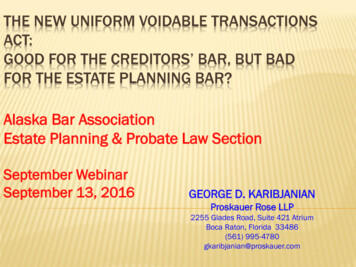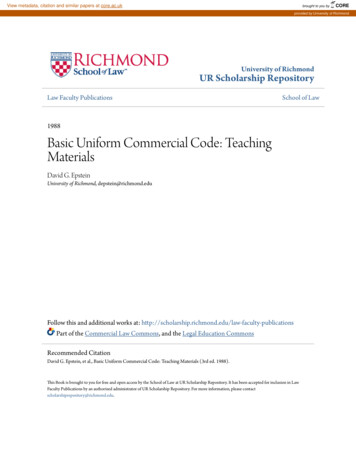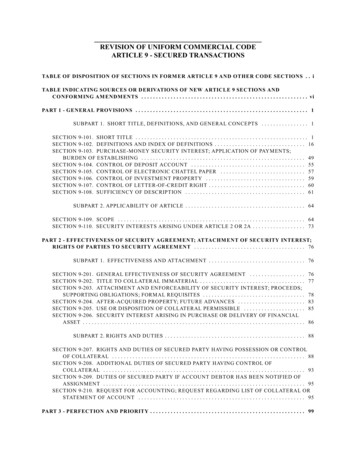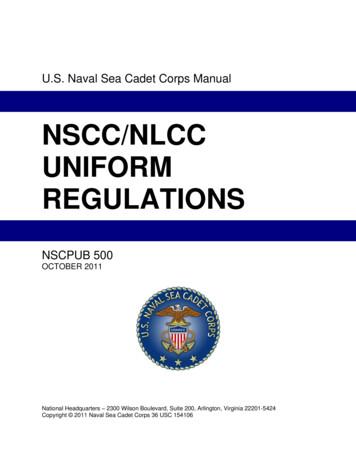
Transcription
THE NEW UNIFORM VOIDABLE TRANSACTIONSACT:GOOD FOR THE CREDITORS’ BAR, BUT BADFOR THE ESTATE PLANNING BAR?Alaska Bar AssociationEstate Planning & Probate Law SectionSeptember WebinarSeptember 13, 2016GEORGE D. KARIBJANIANProskauer Rose LLP2255 Glades Road, Suite 421 AtriumBoca Raton, Florida 33486(561) 995-4780gkaribjanian@proskauer.com
GEORGE D. KARIBJANIANA QUICK EXPLANATION ON WHO I AMGeorge D. Karibjanian is a Senior Counsel in the Personal Planning Department of Proskauer Rose LLP and practices in Proskauer's Boca Raton office. George is BoardCertified by the Florida Bar in Wills, Trusts & Estates and is a Fellow in the American College of Trust and Estate Counsel.He earned his B.B.A. in Accounting from the University of Notre Dame in 1984, his J.D. from the Villanova University School of Law in 1987, and his LL.M. in Taxationfrom the University of Florida in 1988. George has practiced his entire legal career in South Florida (over 27 years), practicing exclusively in the areas of estateplanning and probate and trust administration, and also represents numerous clients with respect to nuptial agreements. George has participated in over 100 formalpresentations, either individually or as part of a panel discussion, to national, state-wide and local groups, and has over 50 publication credits in national and regionalperiodicals and journals. Born and raised in Vineland, New Jersey (in the heart of South Jersey), George has called Boca Raton home since 1988.When not attending Miami (nee Florida) Marlins home games, George is any one or more of being locked to his desk for the better part of the daytime and early eveninghours by security at the One Boca Place office building, reading anything and everything regarding the entertainment industry or is keeping current and/or bingewatching television programming that skews way below his supposed demographic.On January 15, 2014, George was presenter at the prestigious 48th Annual Heckerling Institute on Estate Planning in Orlando, Florida, speaking on a panel discussiontitled, “Living and Working with the Uniform Principal and Income Act,” focusing on the tax effects on the power to adjust trust principal to income, the power to convertan income trust to a unitrust, comparing the various unitrust statues and focusing on potential litigation facing fiduciaries in this area.t:561.995.4780gkaribjanian@proskauer.comOn the topic of same-sex estate planning, George has lectured at various conferences and estate planning councils throughout the United States and has publishednumerous articles in publications such as Steve Leimberg’s LISI Estate Planning Newsletters, Trusts & Estates Magazine and the Florida Bar Journal. George has alsobeen quoted by several publications and websites.George’s other lectures have included topics such as Portability, Decanting, Trustee Selection and Duties, the Principal and Income Act, Current Developments inEstate Planning and Taxation, Representing a Client with Potential Capacity Issues, Whether a Supplemental 706 is Required, Inter-Vivos QTIP Planning and PrenuptialAgreements for the Estate Planner.For the American Bar Association’s Section of Taxation, he is currently serving as the Second Vice-Chair of the Estate and Gift Tax Committee; was the Chairperson for a2011-12 Section Task Force Subcommittee Advocating Changes to the Portability Provisions Added by the 2010 Tax Act; and a contributing draftsman to the Section’s2012 comments to the IRS on decanting.For the American Bar Association’s Section of Real Property Trusts & Estates, he is a current Vice-Chair of the Estate and Gift Tax Committee within the Section’sIncome and Transfer Tax Planning Group.For the Florida Bar’s Real Property Probate & Trust Law Section, he is current Chair for the Section’s Asset Protection Committee; has been the Co-Vice Chair – Probate& Trust and National Events Editor for the Section’s “ActionLine” publication since 2012; the Co-Chairperson of the RPPTL Ad Hoc Committee regarding potentialstatutory changes in light of a change in Florida’s DOMA laws; a member of the Ad Hoc committee to study changes to Florida’s decanting statutes; the Chairperson andprimary draftsman of the Section’s 2012 comments to the IRS on decanting, a member of the RPPTL Ad Hoc Committee that drafted a statutory change in response toFlorida’s Morey v. Everbank decision; and a current member to the Section’s Executive Council.George is also a member of the Greater Boca Raton Estate Planning Council and the South Palm Beach County Bar Association.George is currently on the Professional Advisory Committee for the Boca Raton Museum of Art and for the George Snow Memorial Scholarship Foundation, and is on theExecutive Committee for the Palm Beach County 2015 Wealth & Estate Planning Seminar Previously, George served as President and a member of the Board ofDirectors of the Notre Dame Alumni Club of Boca Raton (1996-1997), a member of the St. Jude's Church (Boca Raton) Financial Education Council (1994-1996), andVice President and a member of the Board of Directors of the Boca Raton Girls Fastpitch Softball Association (2004-2008).September 13, 20162
1. INTRODUCTION TO THE UVTA Adopted by the National Conference of Commissionerson Uniform State Laws at its annual conference inSeattle, Washington during July 2014, the UniformVoidable Transactions Act (the “UVTA”) invites states toreplace the better-known Uniform FraudulentTransfers Act (the “UFTA”).While it is intended to tighten creditors’ laws, does italso catch the “good guy” in the process?September 13, 20163
1. INTRODUCTION TO THE UVTA Status As of June 1, 2016, the UVTA has been adopted in9 states – California, Idaho, New Mexico, NorthDakota, Minnesota, Iowa, Kentucky, North Carolinaand Georgia. Legislation has been introduced for 2016 passagein Indiana (SB 68), Massachusetts (HB 35),Michigan (SB 982), New Jersey (AB 3742), New York(S07687), Rhode Island (HB 7960) and SouthCarolina (HB 5234)September 13, 20164
2. COMMENTS AND WHY THEY MATTER Thoughts from White Paper by the Prof. Ken Kettering,the Reporter for the UVTA: The renaming should not be taken to imply that theUVTA is a new and different act, or that theamendments make major changes to thesubstance of the UFTA. Nothing could be furtherfrom the truth - the UVTA is not a new act; it is theUFTA, renamed and lightly amended.”September 13, 20165
2. COMMENTS AND WHY THEY MATTER Impact of the Comments on Uniform Laws Consider Prof. Kettering’s thought: “The DraftingCommittee’s mandate narrowly limited its authorityto revise the act, but the committee had a freehand to revise and refresh the official commentsas it thought best. Changes to the statute naturallywere accompanied by new and revised comments.”September 13, 20166
2. COMMENTS AND WHY THEY MATTER Impact of the Comments on Uniform Laws How important are the Comments? Jay Adkisson: “The Comments, in short, are nomore than a law journal article on steroids. TheComments are not law, and courts are no morebound by them than they are by any other lawjournal article.” But don’t Comments really express legislativeintent?September 13, 20167
2. COMMENTS AND WHY THEY MATTER Impact of the Comments on Uniform Laws Tax Law has regulations, rulings and case law tointerpret legislative intent. State statutes: equivalent is legislative whitepapers or legislative history. Many states do not publish legislative intent;therefore, without a specific legislative explanationof an adopted uniform law, the only publishedinterpretative authority on uniform law are theUniform Law Committee’s official Comments.September 13, 20168
2. COMMENTS AND WHY THEY MATTER Impact of the Comments on Uniform Laws (cont.) Do courts rely on the Comments? Case law suggests YES. So if the law is “not changed,” then why enact somany new Comments? If the Comments merely reflect the existing law,then the law is already understood HOWEVER inmany instances, there is NO CASE LAW! Thus, if anissue about an adopted uniform statute comesbefore a particular court, what guides the court to adecision? THE COMMENTS!!!September 13, 20169
2. COMMENTS AND WHY THEY MATTER In In re Nocita, 914 S.W.2d 358 (Mo. 1996), theMissouri Supreme Court stated that “Whenconstruing uniform and model acts enacted bythe General Assembly, we must assume it did sowith the intention of adopting the accompanyinginterpretations placed thereon by the drafters ofthe model or uniform act Generally, commentsaccompanying a uniform code when adoptedhave great weight in construing the code.”(Emphasis added.) In re Nocita at 359.September 13, 201610
2. COMMENTS AND WHY THEY MATTER In Yale University v. Blumenthal, 624 A.2d 1304, 225Conn. 32 (Conn. 1993), the Connecticut SupremeCourt stated that “A court can properly consider theofficial comments as well as the published commentsof the drafters as a source for determining themeaning of an ambiguous provision [of a uniformact].” (Emphasis added). Yale University at 1304, 38.September 13, 201611
2. COMMENTS AND WHY THEY MATTER In Coker v. Abell-Howe Company et. al., 491 N.W.2d143 (Iowa 1992), the Iowa Supreme Court stated that“The official comments to the Uniform Act have somepersuasive influence in determining what ourlegislature intended by the language in ourcomparative fault act.” (Emphasis added.) Coker at148.September 13, 201612
2. COMMENTS AND WHY THEY MATTER In Jeld-Wen, Inc. v. Pacificorp et. al., 245 P.3d 685,240 Or.App. 124 (Ore. Ct. App. 2010) the OregonCourt of Appeals stated that “Commentary to auniform law adopted in Oregon serves as legislativehistory.” (Emphasis added.) Jeld-Wen, Inc. at 687,129.September 13, 201613
2. COMMENTS AND WHY THEY MATTER In Havens v. Portfolio Investment Exchange Inc., 983F.Supp.2d 1007 (N.D. Ind. 2013), the Northern Districtof Indiana, South Bend Division stated that “Indianalaw is quite clear that model or uniform commentary ispersuasive when construing an ambiguous statute.”(Emphasis added.) Havens at 1011.September 13, 201614
2. COMMENTS AND WHY THEY MATTER In In re Menashe, 301 B.R. 757 (S.D. Fla. 2003), theU.S. Bankruptcy Court in the Southern District ofFlorida stated that “[w]hile the official comments tothe Uniform Commercial Code are not controlling asan absolute expression of legislative intent, they are a‘valuable aid’ in the construction of code provisions.”(Emphasis added.)September 13, 201615
2. COMMENTS AND WHY THEY MATTER Instead of letting the law evolve judicially based onprior precedents, the new Comments will ultimatelygive the particular court a “push” to a conclusionbased on the Committee’s viewpoint and notnecessarily that of existing applicable state law.Comments and Estate Planning - while the UVTA ishelpful to the creditors’ bar, the impact of theComments will be felt among the estate planning barin that broad latitude and interpretation can be givento hamper certain planning techniquesSeptember 13, 201616
3. POTENTIAL ESTATE PLANNING RAMIFICATIONS 5 impacted areas: (1) Asset Substitution (2) Entity Formation (3) Entity Conversion (4) Domestic Asset Protection Trusts (5) Homestead lawSeptember 13, 201617
3A. ISSUE #1 – ASSET SUBSTITUTION§4(a)(1):“SECTION 4. TRANSFER OR OBLIGATION VOIDABLEAS TO PRESENT OR FUTURE CREDITOR.(a) A transfer made or obligation incurredby a debtor is voidable as to a creditor, whether thecreditor’s claim arose before or after the transfer wasmade or the obligation was incurred, if the debtormade the transfer or incurred the obligation:(1) with actual intent to hinder,delay, or defraud any creditor of the debtor; or”September 13, 201618
3A. ISSUE #1 – ASSET SUBSTITUTIONApplies to ANY creditor, meaning a past, present orFUTURE creditorParagraph 3 of new Comment 8:A transaction that does not place an asset entirelybeyond the reach of creditors may nevertheless“hinder, delay or defraud” creditors if it makes theasset more difficult for creditors to reach. Simpleexchange by a debtor of an asset for a less liquidasset, or disposition of liquid assets while retainingilliquid assets, may be voidable for that reason.September 13, 201619
3A. ISSUE #1 – ASSET SUBSTITUTIONWhat word is missing from Paragraph 3? INTENT!!!Is the Committee stating that in interpreting §4,“intent” is actually de facto present?Doesn’t this run afoul of new §4(c), which tries toestablish the burden to be on the CREDITOR?September 13, 201620
3A. ISSUE #1 – ASSET SUBSTITUTION“Intent” Black’s Law Dictionary - “[p]urpose; formulateddesign; a resolve to do or forbear a particular act;aim; determination.” Intent is also illustrated under the §4(b) nonexclusive list of “badges of fraud” “Intent” is actually an open-ended concept subjectto great interpretation, so it could be argued thatthe “intent” behind this provision is to make asweeping generalized statement that any assetexchange for a less reachable asset is voidable.September 13, 201621
3A. ISSUE #1 – ASSET SUBSTITUTIONCases? Not many on this topic.Example #1: Dean, Stu, Claire and the 2012Intentionally Defective Grantor Trust What if nothing regarding asset protection is said? What if someone unrelated to the transactionreferences asset protection? Ramification of unwinding asset substitution.September 13, 201622
3B. ISSUE #2 – ENTITY FORMATIONIntroduction - Paragraph 6 of Comment 8: Relates to entrepreneurs forming an entity, with noanticipation of any personal liability in the nearfuture. Assuming that the entity is formed in the homestate, the transfers are not voidable under §4(a)(1)as in force in the same state. By contrast, if personal liability or distress ispresent for some of them with the thought of takingadvantage of the LLC’s anti-creditor feature, thetransfer should be voidable under § 4(a)(1),September 13, 201623
3B. ISSUE #2 – ENTITY FORMATIONProblems with Paragraph 6: choice of words and lackof guidance in interpreting meaning. What exactly is meant by an “ordinary situation” inthe context of “none of the owners has particularreason to anticipate personal liability or financialdistress”? What “reasons” should a person be anticipating? How broadly should “financial distress” be analyzedby potential partners, shareholders and members?September 13, 201624
3B. ISSUE #2 – ENTITY FORMATIONExample 2 – Steve, Chevy and Martin and formationof Nevada LLC What is the “ordinary situation?” Is changing operations to transportation ofdangerous chemicals outside of “ordinarysituation”? Does it mean any risk in the business operationsis a per se violation? What is “risk” – does it also include financial risk?September 13, 201625
3B. ISSUE #2 – ENTITY FORMATIONWhy “voidable at any cost?” So, “two microscopic badapples spoil the fun for everyone by breaking therules?”Example 3 – does Paragraph 6 wipe out an entireentity formation even if the offending owners owncombined less than 1% membership interests?September 13, 201626
3B. ISSUE #2 – ENTITY FORMATIONState Law and Voidability As will be seen with DAPT’s and Issue #4, state lawmay be relevant in upholding certain transactions. Note in Paragraph 6 where it states that the entityin question is formed “in the same state”, inferringthe same state as the debtor. (see p.10) Paragraph 7 would void a transfer to a DAPT inanother jurisdiction. Can this logic be applied into Paragraph 6?September 13, 201627
3C. ISSUE #3 - ENTITY CONVERSIONMany entities are converted into LLC’s and FLP’s totake advantage of the “charging order” protection.However, entities are converted for many otherreasons, such as to take advantage of lower tax ratesor better business laws.September 13, 201628
3C. ISSUE #3 - ENTITY CONVERSIONParagraph 4 of Comment 8: “ §4(a)(1) would render voidable an attempt bythe owners of a corporation to convert it to adifferent legal form (e.g., [LLC or FLP]) with intent tohinder the owners’ creditors, as may be the case ifan owner’s interest in the [LLC or FLP] would besubject only to a charging order If such aconversion is done with intent to hinder creditors, itcontravenes §4(a)(1) regardless of whether it iseffected by conveyance of the corporation’s assetsto a new entity or by conversion of the corporationto the alternative form .”September 13, 201629
3C. ISSUE #3 - ENTITY CONVERSIONExample 4 – Brian, Chris and David, with theconversion of an S corporation to an LLC for ease offamily wealth transfers but also with awareness of thecharging order protection.September 13, 201630
3C. ISSUE #3 - ENTITY CONVERSIONExample 4 – Brian, Chris and David, with theconversion of an S corporation to an LLC for ease offamily wealth transfers but also with awareness of thecharging order protection.September 13, 201631
3D. ISSUE #4 – DOM. ASSET PROTECTION TRUSTSStarting with Alaska in 1997, there are now 15 statesas of January 1, 2016 that have enacted full DAPTlegislation.No “hidden agenda” in the UVTA as to DAPTs: theWhite Paper states, “The avoidance laws of somejurisdictions are substantially debased by comparisonwith the UVTA. That is notably so in “asset havens”that have eviscerated, or completely expunged, theiravoidance laws.”This, it is stated, is a primary reason for the adoption§10 and its governing law provision.September 13, 201632
3D. ISSUE #4 – DOM. ASSET PROTECTION TRUSTSCommon perception of a DAPT - DAPTs are atechnique only used by the “shady” debtor, so theUVTA was given additional “bite” to go after DAPTs.Two sections within the UVTA affect DAPT planning §4 and the aforementioned new §10.September 13, 201633
3D. ISSUE #4 – DOM. ASSET PROTECTION TRUSTSComment 2 to §4: “ For example, promptly after the invention inPennsylvania of the spendthrift trust, the assetsand beneficial interest of which are immune fromattachment by the beneficiary’s creditors, courtsheld that a debtor’s establishment of a spendthrifttrust for the debtor’s own benefit is a voidabletransfer under the Statute of 13 Elizabeth, withoutregard to whether the transaction is directed at anexisting or identified creditor.”September 13, 201634
3D. ISSUE #4 – DOM. ASSET PROTECTION TRUSTSLast 3 Sentences of Paragraph 7 to Comment 8: “By contrast, if Debtor’s principal residence is injurisdiction Y, which also has enacted this Act buthas no legislation validating such trusts, and ifDebtor establishes such a trust under the law of Xand transfers assets to it, then the result would bedifferent. Under §10 of this Act, the voidabletransfer law of Y would apply to the transfer. If Yfollows the historical interpretation referred to inComment 2, the transfer would be voidable under§4(a)(1) as in force in Y.”September 13, 201635
3D. ISSUE #4 – DOM. ASSET PROTECTION TRUSTSParagraph 7 of Comment 8 invokes Section 10 ofwhich (b) provides:“(b) A claim for relief in the nature of a claim forrelief under this [Act] is governed by the local law ofthe jurisdiction in which the debtor is located whenthe transfer is made or the obligation is incurred.”September 13, 201636
3D. ISSUE #4 – DOM. ASSET PROTECTION TRUSTSSo what is the Committee’s end-game on DAPTs? The Committee claims that the language of§4(a)(1) historically has been interpreted to rendervoidable a transfer to a DAPT. “Domicile State” vs. “DAPT State” By fixing the governing law, the hope is to force theapplication of the laws of the Domicile State to theDAPT State with a Full Faith & Credit argument. By applying Comments 2 and 8, it appears that theintent is that any transfer to a DAPT is voidable.September 13, 201637
3D. ISSUE #4 – DOM. ASSET PROTECTION TRUSTSWhat about the “Self-Settled Spendthrift Doctrine”?Comment 2 seemingly tries to adopt a global“voidable per se” approach to DAPTs, but ignores thefact that in many states, transfers to DAPTs mayactually be subject to the “self-settled trust doctrine.”SSTD is a separate rule which provides that aspendthrift restraint on alienation is not valid withrespect to any interest retained by the settlor.Thus, if a settlor transfers property to a spendthrifttrust and retains a right to trust income for life (but notprincipal), only the income is subject to attachment.September 13, 201638
3D. ISSUE #4 – DOM. ASSET PROTECTION TRUSTSArguments Against Strict Interpretation of theComments Unless and until all 50 states and the District ofColumbia adopt the UVTA and §10, DAPTproponents still have the ability to uphold the DAPT.September 13, 201639
3D. ISSUE #4 – DOM. ASSET PROTECTION TRUSTSArguments Against Strict Interpretation of theComments Which Law Applies – Voidable Transactions Law orConflicts of Law? Both sets of laws – voidabletransfers and self-settled trusts – have theirrespective origins in different centuries: Fraudulent-transfer rules - Statute of 13Elizabeth (1570), Rule against self-settled trusts - Statute of 3Henry VII (1487).September 13, 201640
3D. ISSUE #4 – DOM. ASSET PROTECTION TRUSTSArguments Against Strict Interpretation of theComments The only legal precedent cited are three ancientPennsylvania cases Unless a state has determined, either by judicialdecision by the highest court in the state or byspecific statutory law, that transfers to self-settledtrusts are “per se voidable,” then it would appearthat the statements in Comments 2 and 8 aboutDAPTs should only apply as to Pennsylvania.September 13, 201641
3D. ISSUE #4 – DOM. ASSET PROTECTION TRUSTSArguments Against Strict Interpretation of theComments Conflicts of Laws Restatement §273 and its PublicPolicy statement vs. Conflicts of Laws Restatement§270, which does contain a Public Policycomponent Absence of a position is not a public policystatement – has to be specific or by negativeinference Huber and disregarding §273September 13, 201642
3D. ISSUE #4 – DOM. ASSET PROTECTION TRUSTSArguments Against Strict Interpretation of theComments §10 tries to create a “back door” public policystatement by negative inference – if transfers fromDomicile State to DAPT State are voidable, then itcan be inferred that the state has a public policyagainst DAPTs. What about “Non-Evil” DAPTs? The case for theInter-Vivos QTIP Trust. Unintentional death to ING Trusts?September 13, 201643
3D.ISSUE #4 – DOM. ASSET PROTECTION TRUSTS Should DAPT States Worry? Seems like none haveadopted the UVTA. Answer – YES! Enforcement and Full Faith & Credit Full Faith & Credit – would be granted, but subject toenforcement under DAPT state’s lawsSeptember 13, 201644
3D. ISSUE #4 – DOM. ASSET PROTECTION TRUSTSExample: A, a resident of State X, transfers 4,000,000 into aDelaware DAPT. A’s remaining assets are 5,000,000 in securities held withher husband as tenants-by-the-entirety (and evendocumented as such with the financial institution) and a 3,000,000 home that qualifies as exempt under the StateX’s homestead laws. Two years after the creation of the DAPT, A business matterinvolving A goes awry and A is sued by B, who obtains ajudgment in State X for 2,500,000. A only has insurance coverage of up to 1,000,000, therebyleaving a gap of 1,500,000. B seeks to enforce thebalance of the judgment in Delaware as to the DAPT.September 13, 201645
3D. ISSUE #4 – DOM. ASSET PROTECTION TRUSTSWhat Happens If: UVTA Not in Effect in Resident State Summary judgment likely UVTA in Effect in Resident State If per se voidable, then second action can bebrought to assimilate “actual intent” which moreclosely mirrors DAPT state’s statutes allowingattachmentSeptember 13, 201646
3E. ISSUE #5 – HOMESTEADIntroduction Certain states exempt from creditor claims“homestead” property. The degree of exemption allowed may vary greatly,with Tennessee providing for a very minimalexemption as opposed to Florida which allows foran almost unlimited exemption. Example of how far Florida will take homesteadprotection - HavocoSeptember 13, 201647
3E. ISSUE #5 – HOMESTEADUnder Sec. 10(b), the UVTA can allow one state’s lawto dictate a change in the homestead laws of anotherstate.Example 6 – Alexander, Aaron and Tennesseejudgment enforced in Florida (p. 31)September 13, 201648
3E. ISSUE #5 – HOMESTEADThe effect of the homestead scenario is that ascenario could exist where two debtors could be livingnext to each other, with the same facts as it relates toa voidable transactions claim, except that onepurchased her Florida homestead when “located” inCalifornia and the other purchased her homesteadwhen “located” in Florida, and the former Californiaresident could face a loss of certain homesteadprotections whereas the long-time Florida residentmay notSeptember 13, 201649
3E. ISSUE #5 – HOMESTEADIs Example 6 a Fraudulent Transfer or Conversion? Creditors’ rights attorneys usually argue both When non-resident purchases property, asset is not“converted” into an exempt asset because only aFlorida domiciliary can obtain homesteadprotection; what happens is a reachable asset(cash) has been exchange for a more difficult toreach asset (out of state real property)September 13, 201650
4. CONCLUSION For states where the UVTA has NOT BEEN PASSED,the estate planning bars should be aware of therepercussions and do one of two things: Prevent passage If passage is inevitable, press for a specific statutepreventing the application of the Comments.September 13, 201651
4. CONCLUSION (a) Prevent Application of the Comments §15Legislative Intent. Although this Act is adopted, in part, from theUniform Voidable Transactions Act as releasedby the National Conference of Commissioners onUniform State Laws, the official Comments to theUniform Voidable Transactions Act, as amendedfrom time to time, shall not, in any manner,whether directly or indirectly, be relied upon, ininterpreting this Act.September 13, 201652
4. CONCLUSION (b) Prevent voidable per se §9Defenses, Liability, and Protection ofTransferee or Obligee. (i)Notwithstanding the foregoing provisions ofthis Act: (1) Nothing in this Act shall deem asvoidable per se the transfer of an asset by a debtorresiding in this state to an entity or irrevocable trustthat is formed and governed under the laws offoreign jurisdiction; provided, however, that suchtransfer may nevertheless be deemed voidablepursuant to other provisions of this Act.”September 13, 201653
4. CONCLUSION(c)Prevent Use of Judgment as Enforcement in ForeignState (2)A judgment under this Act may not be satisfied orenforced against any entity, or an interest in such entity, owned by thedebtor (or a trust that is revocable by the debtor) that is organized underthe laws of a foreign jurisdiction, or against any irrevocable trust createdby the debtor in which the debtor has retained a beneficial interest andwhich is governed under the laws of a foreign jurisdiction, unless:(i)The Claims Laws of the foreign jurisdictiongoverning such entity or trust, independent of the effect of the judgmentunder this Act, permit such judgment to be satisfied from, or enforcedagainst, such entity, or interest in such entity, or trust; or(ii)(A)Such entity or trust was createdbefore the particular transfer made, or obligation incurred, by the debtorresulting in such judgment, and(B)The assets held by such entity ortrust were transferred by the debtor to such entity or trust in violation ofanother provision of this Act.September 13, 201654
4. CONCLUSION (d) Homestead Protection §10Governing Law. (c)The provisions of this section shall notaffect the governing law for any other claims orissues between the parties arising outside of theprovisions of this Act. If this section requires theapplication of the Claims Laws of a foreignjurisdiction, such a determination will not affectwhich jurisdiction’s exemption laws apply, theavailability of exemptions under applicable law[, orthe debtor’s entitlement to any protections affordedto the debtor’s homestead under the [State]Constitution.”September 13, 201655
4. CONCLUSION For those states where the UVTA has ALREADYPASSED the estate planning bars should do twothings: Alert their membership as to the potential pitfallsthat may now face estate planning attorneys whenengaging in commonly-used techniques such asasset substitution and entity formation. Press for legislative statement of non-acquiescenceto the UVTA-added Comments.September 13, 201656
George is also a member of the Greater Boca Raton Estate Planning Council and the South Palm Beach County Bar Association. . (Boca Raton) Financial Education Council (1994-1996), and Vice President and a member of the Board of Directors of the Boca Raton Girls Fastpitch Softball Association (2004-2008). 1. INTRODUCTION TO THE UVTA










